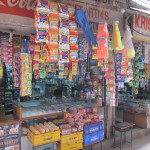
After a few months touring the length and breadth of India, we gained a good idea of how the cities look and how the daily life works. We know generally how to find the supplies we need – what you can get at the kiranas, the small convenience stores that are the core retail unit of India. We know what you get at the chemist’s (pretty much anything and without a prescription), the dairy, the electrical supply place, and so on. It can be tougher to locate these when we have stayed in the newer outlying enclaves, the suburbs, but once found these shops don’t differ much.
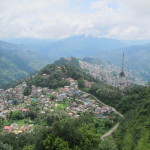
That’s not to say that each town looks exactly the same, far from it. The winding, climbing streets of hill towns look nothing like those of the plains. The old colonial centers of Kolkata, Pondicherry and Goa are distinctive in their own British, French and Portuguese ways. You cannot confuse Mumbai and Delhi except perhaps in the slums or far-flung enclaves. In Rajasthan, the pink city of Jaipur, the lake city of Udaipur, the blue city of Jodhpur and the golden city of Jaisalmer all look very different – in architecture and layout. Region by region, the cities even offer a different cuisine and speak different languages.
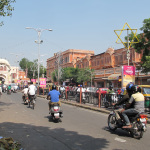
But after a while in India, we could come into a new city, recognize it as distinctly India, plus figure out how to function.
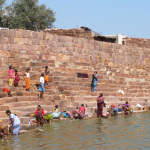
The most noticeable characteristic of an Indian town is how the streets look, smell and sound. One of India’s great paradoxes is that individually people are obsessive about cleanliness: they thoroughly wash hands before meals mostly eaten by hand, shop owners and residents keep sweeping dust and dirt off their porticoes, women slap their clothing on the waterside ghats.
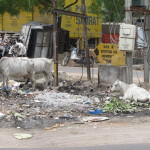
But habitually people toss refuse and trash and what-all into the streets, where animals pick at it, the poor pick thru it to recycle things, and people pick their way around it. In the hilly north and in the south, the conditions are usually better, but not always.
And animals are everywhere, even in the older parts of the biggest cities. Packs of village dogs, mostly asleep during the day, seem to own the night, making a howling racket in defense of their territories. Cattle abounds, with goats, pigs, and cows roaming the streets and highways, processing some of the waste disposed along the streets, then disposing of their own.
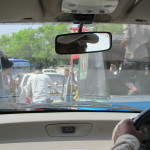
Dung, dust, rotting food, sewage flowing just below the street, sweaty people, diesel fuel, burning waste, as well as the powerful scents of Indian cooking on the streets – all combine to assault the nose. The ears don’t fare much better. Rattling rickshaws and grumbling trucks form a bass line to the relentless horn honking practiced by Indian drivers. That’s how drivers signal where they are on the road, or ward off people and cattle – in a cacophony of different tones. You might also hear the frequent loud ‘Hello’ of people trying to hear – and be heard – on their mobiles above the racket. There’s also the clamor of loud conversation typical even to talk to a person nearby. We kept wondering if most were going deaf after living here long enough.
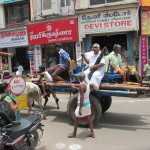
As for finding your way around, small towns and villages tend to look the same across India: one or two dusty streets lined with small shops in one to three story buildings depending on town size. The streets offer a surprising number of kiranas (how do they compete?) mixed in with various kinds of service shops. You see a profusion of signs in local language and often English as well, some well worn and some freshly delivered by the big companies like mobile services or soft drinks or the ubiquitous cement suppliers. The larger towns have a bustling village market as well.
Most larger towns center on a core of narrow streets, think bazaar (like old Delhi), and spoke/wheel roads funneling traffic in and out. The ones important to the colonial rulers overlaid the original towns with boulevards and roundabouts in the 19th and 20th century. Naturally, specialty areas arose for, say, machinists or textiles or furniture or even money, like the financial center at the Fort region of Mumbai.
With great growth from inside and out of the bigger cities, the old parts are where the new immigrants and poorer congregate. For the new money, escaping the core city, rapid expansion has added oddly shaped enclaves. Those meticulously geometric spaces – sometimes elliptical, sometimes rectilinear, sometimes a doodle’s combination – feature what seemed to be a bizarre numbering system for streets or blocks. Block L-6, Lajpat Nagar 3 turned out to be a specific building in one of a set of loops dangling off a rectangular part of that enclave. It was mystifying at first, but eventually we got the logic, and the rickshaws did know where to go – roughly – and deftly found the least trafficked way to get there.
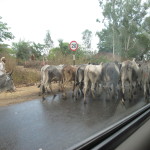
For traffic in India’s big cities is intense at the best of times, with driving rules an arcane art practiced by the sadhus of the road. Where the British or the local rajahs of the past insisted on those boulevards and grand roundabouts, traffic can move surprisingly well. But the cities are just too crowded for smooth flow. And all the roads are shared among cars, trucks, pedestrians, scooters, bicycles – and livestock. The bulls in particular think they own the road and rarely yield to anyone.
So traffic is pretty much a free for all, particularly in those cities like Delhi and Chennai where new metro extensions have torn up the major intersections. It took us three hours just to penetrate Delhi one evening; an hour to get from one corner of Chennai to another. The metros should help eventually: the efficient and pleasant system in Delhi has reportedly made a huge difference already – where it runs. The local busses run every which way, and to the short-time visitor virtually impossible to figure out. That leaves the auto-rickshaws or tuk-tuks as the primary point-to-point conveyance, most often negotiated in rate, but occasionally as in Bangalore on a well-working metered system.
Between towns and cities, local roads are pretty bad, potholed and rubbly even at the best of times, with too little maintenance. Slowly, highways are evolving to connect places, but even these are often partly finished – and prone to attracting cattle as well. The best we found were in the south and from Delhi to Agra, the tourist track. When you do find a good road, savor it as long as you have it. For long distances, if at all possible, take the train.
Just as with the geography, after a while we learned how to handle the daily needs of life.
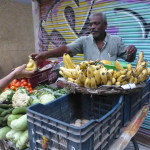
Food shopping, from the smallest towns to the biggest cities, is a street affair. Carts, more permanent stalls and market centers filled with both dominate the food buying. There are few supermarkets except in the newer developments or colonies, and these find it hard to compete for freshness and quality with the local pushcart man. Only in the posh neighborhoods carts tend to disappear, as modest-sized supermarkets with other consumables offer consistency and fixed pricing and some imported goods (including western fare like tofu or cheese) – at upper class prices.
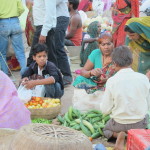
So even though big box stores are taking root particularly for non-perishables, to most Indians, the stalls and open-air markets are the best value for foods. And we came to prefer those too, unless we needed a fix of western comfort foods. For residents, the local guy often becomes part of your extended family, looking out for what you need and when.
The kiranas fill in with the rest of domestic needs: small packets of laundry detergent, eggs, yoghurt, biscuits, beans and pulses, etc. Other western-style products have infiltrated even the smallest shops: salty snacks from Frito-Lay, sugary soft drinks from Pepsi and Coke, breakfast cereals like corn flakes from Kellogg’s.
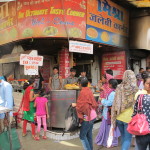
Similarly, local prepared food is available everywhere in town, as Indians like to eat often – street carts and permanent stalls may look dicey, but where the crowds collect the food is usually quite good. More formal family restaurants with extensive seating proliferate in the bigger towns. Non-Indian cuisine, however, is rare except for high-end neighborhoods, hotel restaurants and touristy places. Even so, places offering “international multi-cuisine” typically add just a potpourri of Chinese noodle dishes and somewhat Italian pastas.
As for alcohol, though some cities and states are acting to restrict sales to their citizens, especially in the south, you can find liquor stores or bottle shops all over town. They’re typically tucked away on side streets in some towns or in busy centers in others. You get used to finding these shops, a particularly easy task in Tamil Nadu. Its state-authorized Tasmac stores always have a crowd out front, especially after work hours, and are defended by a strong wire mesh barrier.
Bars are infrequent except in more expensive restaurants and hotels welcoming foreigners, though Karnataka has put the bars and bottle shops together. The other oddity is that many are named English Wine Shops, presumably because the English drank wine rather than produced it. Hardly any have wine however except red of a sweet variety, if at all.
The bottle shops are also one of the last bastions of bargaining, as the official price printed on the bottle is just the starting point for a demand for some new higher price, or coverage of higher taxes, or some reason to request more. We became very good at negotiating.
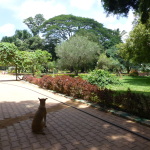
Even with a lot of experience, the cities and towns were hardly relaxing places. Yet, even so, you could find some grace notes. In most good-sized towns, green spaces are everywhere, pocket parks, gardens, large reserves that were often the former domains of native or colonial rajas, Oddly, these are typically surrounded by walls with entrances or exits tough to find, as if they were too good for the locals or perhaps not to be trusted to them. In mornings and evenings, many residents are walking these paths for exercise. Along the coasts, as in Goa and Pondicherry, the street foliage has a somewhat tropical feel. Elsewhere, on some of the grander boulevards of Mumbai or Delhi or Chennai, tall trees overhang the roads, with an occasional European allee for shade.
It might be tough to get into the green space, but that’s the best way – after just being a tourist or after a day at work – to mix with the locals, screen out much of the noise and aroma, escape the heat and traffic – and languidly enjoy the city.
(Also, for more pictures from India, CLICK HERE to view the slideshow at the end of the India itinerary page.)



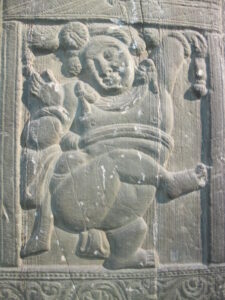
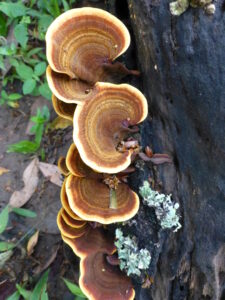
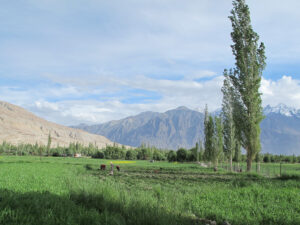
Well described! For a second I thought I was back there and my heartrate spiked…!